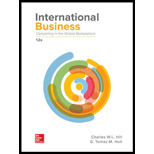
To discuss: The difference in the percentage in foreign direct investment (FDI) inflows in Country I and Country J.
Introduction:
Gross fixed capital formation is the investment in the fixed assets like warehouses, retail stores, and factories.
Explanation of Solution
The difference in the percentage in foreign direct investment (FDI) inflows in Country I and Country J are as follows:
The difference in the percentage in foreign direct investment (FDI) inflows in Country I and Country J mainly because of the government policies
Country I is basically a friendly FDI whereas Country J is not as such kind. Country J does not encourage inward FDI. Though these two countries are trade dependent economies with limited available resources Country I is comparable less mercantile in attitude with that of Country J. Country I has relatively low cost workforce, ample supply of labor and well educated.
Whereas work force of Country J is well educated is more expensive than the Country I.
Want to see more full solutions like this?
Chapter 8 Solutions
International Business: Competing in the Global Marketplace
- Calculate the standard direct material quantity per unit general accounting question need answerarrow_forwardThe Parks Corporation manufactures and sells Bluetooth speakers. Each speaker sells for $29.50 and the variable cost per unit is $18.75. Parks's total fixed costs are $30,000, and budgeted sales are 6,000 units. What is the contribution margin per unit?arrow_forwardNonearrow_forward
- On April 1, Usain Enterprises purchased machinery at a cost of $150,000, with a depreciable cost of $120,000 and an estimated useful life of 4 years. Using the straight-line depreciation method, calculate depreciation expense for the first year, which ends on December 31. a. $22,500 b. $30,000 c. $15,000 d. $45,000 MCQarrow_forwardPlease solve this General accounting questions step by steparrow_forwardGeneral Accountingarrow_forward
- General accounting questionarrow_forwardThis question is regarding business negotiation BUS356 in SUSS. The case below is extracted from Harvard Business Review Case Study “Move Fast,but without Bias: Ethical AI Development in a Start-up Culture”. It is important to support your answers with specific examples based on thescenario given in the case study below to demonstrate your understanding andapplication of the relevant concepts. You may make reasonable assumptions, aspart of your analysis. Answers must be supported with theoretical models and concepts from therecommended textbook, Lewicki, R. J., Saunders, D. M. & Barry, B. (2021). Essentialsof Negotiation (7th ed). New York: McGraw-Hill International Edition and coursematerials. Please provide useful links and citations for learning purposes.arrow_forwardDelta Corporation has the following capital structure: Cost Weighted (after-tax) Weights Cost Debt 8.1% 35% 2.84% Preferred stock (Kp) 9.6 5 .48 Common equity (Ke) (retained earnings) 10.1 60 6.06 Weighted average cost of capital (Ka) 9.38% a. If the firm has $18 million in retained earnings, at what size capital structure will the firm run out of retained earnings? b. The 8.1 percent cost of…arrow_forward
 Foundations of Business (MindTap Course List)MarketingISBN:9781337386920Author:William M. Pride, Robert J. Hughes, Jack R. KapoorPublisher:Cengage Learning
Foundations of Business (MindTap Course List)MarketingISBN:9781337386920Author:William M. Pride, Robert J. Hughes, Jack R. KapoorPublisher:Cengage Learning Foundations of Business - Standalone book (MindTa...MarketingISBN:9781285193946Author:William M. Pride, Robert J. Hughes, Jack R. KapoorPublisher:Cengage LearningMarketingMarketingISBN:9780357033791Author:Pride, William MPublisher:South Western Educational Publishing
Foundations of Business - Standalone book (MindTa...MarketingISBN:9781285193946Author:William M. Pride, Robert J. Hughes, Jack R. KapoorPublisher:Cengage LearningMarketingMarketingISBN:9780357033791Author:Pride, William MPublisher:South Western Educational Publishing




